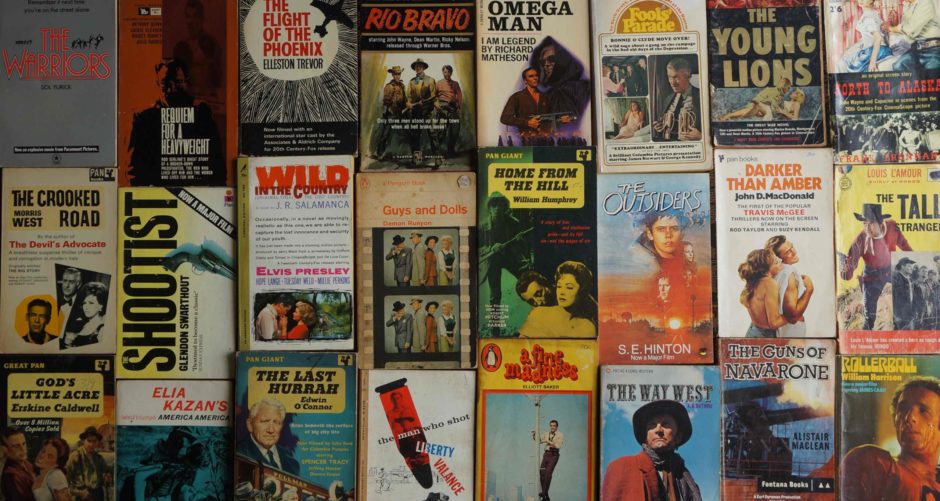 THE FILM (Made for Television)
THE FILM (Made for Television)
FILM DIRECTOR: Robert Totten
SCREENWRITER: Ron Bishop, Robert Totten
FILM STARS: Henry Fonda, Maureen O’Hara, Ben Johnson, Jack Elam, Clint Howard, Julian Rivero, Roy Jenson, Lieux Dressler, Richard Jaeckel, Woody Chambliss, Link Wyler, Warren Douglas, Rance Howard as Sheriff Bill Smith
COUNTRY: USA
THIS BOOK
AUTHOR: John Steinbeck
TYPE: Novella
PUBLISHER: Corgi
THIS EDITION PUBLISHED: 1973
COUNTRY: Great Britain
COVER: Paperback
THE ORIGINAL BOOK
ORIGINAL AUTHOR: As Above
YEAR FIRST PUBLISHED: 1937
ORIGINAL BOOK TITLE: The film title
NOTES
GENRE: Western
WORDS: Steinbeck’s “The Red Pony” is four interrelated stories published separately (the first three chapters were published in magazines from 1933 to 1936) then collected into book form in 1937 (actually it is sometimes referred to as an episodic novella which is a printing by which a single larger work, often a work of narrative fiction, is published in smaller, sequential instalments). Not sure if that applied here as the stories, I believe, were written at different times.
The stories in the book are about a boy (aged from 10 to 12) named Jody Tiflin and his life on his father’s California ranch (where else for Steinbeck?) situated in the Salinas Valley between the Santa Lucia and Gabilan Mountains at the turn of the twentieth century.
Steinbeck had a way with characters. His books are always readable and what seem to be simple stories always hide more complex themes underneath. Steinbeck was, in the 30s, quite a political and socially conscious writer though his earlier books (including this one) would not indicate that. “The Red Pony” was his third though it wasn’t released until 1937 and after the his first critical success with Tortilla Flat (1935). It is full of the keen observations on the lives of the families that live on the land seen from, or focussing on, a boy coming of age (they “came of age” a lot earlier then … he would be gaming till he was 25 if set now). The earlier works lack the bite that comes with later Steinbeck but they still resonate in their description of time and place, the relationships between people and their humanism.
Steinbeck is one of my favourite writers or, rather, still is, as I read most when I was in my 20s and haven’t read much recently. But, I recall them fondly. Maybe he has faults but I tend to overlook them. His tales are full of humanity and understanding that transcends the anger over the exploitation he saw which is the focus of some of his more well know novels (In Dubious Battle (1936) The Grapes of Wrath (1939)). I should read more as Steinbeck, like many writers today, can be dark and cynical but, unlike many today, his cup is half full making him a great humanist.
The most famous version of this film is the glorious 1949 technicolour version produced and directed by (the great) Lewis Milestone for Republic Pictures, and starring Myrna Loy, Robert Mitchum, and child actor Peter Miles. This version made for television in 1973 doesn’t look as good but has an equally impressive cast and more bite. The first film is family oriented and concentrates on the a boys coming of age and has a wonderfully appealing performance by Mitchum as ranch hand Billy Buck and the beautiful Myrna Loy as the mother. Steinbeck himself adapted the novel for the 1949 film and he focused mainly on the chapters “The Gift” and “The Promise,” thereby increasing the role of Billy Buck whilst changing some characters names, and adding a happier ending.
The second version has Henry Fonda and Maureen O’Hara at their best (though both are, perhaps, to old for their roles) with a young Clint Howard as the boy (though it’s hard to reconcile that Clint with any number of eccentrics he played in later years). This version is more darker and adult oriented than the earlier version and is less about the pony than the antagonistic relationship of aging farmer Fonda and sensitive son Howard.
Both films may be based on the same story but they look at the same theme through different lenses. The former is family oriented, the latter reality (well as real as you can get for a Made for TV film in the 1970s), but both are just different views of the same themes – the cruelty of nature (including death, graphic descriptions of animals in distress, and a horse breeding scene), major childhood sadness, and the fallibility of adults as themes (amongst others)). That’s not to say there aren’t family elements in the latter film or realistic elements in the former.
By their nature both films are episodic though the first was better crafted. The 1973 film has all the restrictions of a Made for Television movie … smaller budget, cheaper sets, smaller crew who normally work quickly in television (both director writer Totten and co-writer Bishop worked almost exclusively in American television). But what it lacks there it makes up for in cast … apart from the leads you have Ben Johnson (almost straight off the back of his best supporting Oscar win for The Last Picture Show (1971)), Jack Elam, Richard Jaeckel and Rance Howard (Clint Howard’s real life father, and older brother Ron Howards father as well).
Both films are fine, though the first resonated more with me probably because I saw it first at a young age.
THE FILM


yep re Kirk … no one pushes Kirk around. His Bryna Production Company was involved with (partially funded) POG ..and…